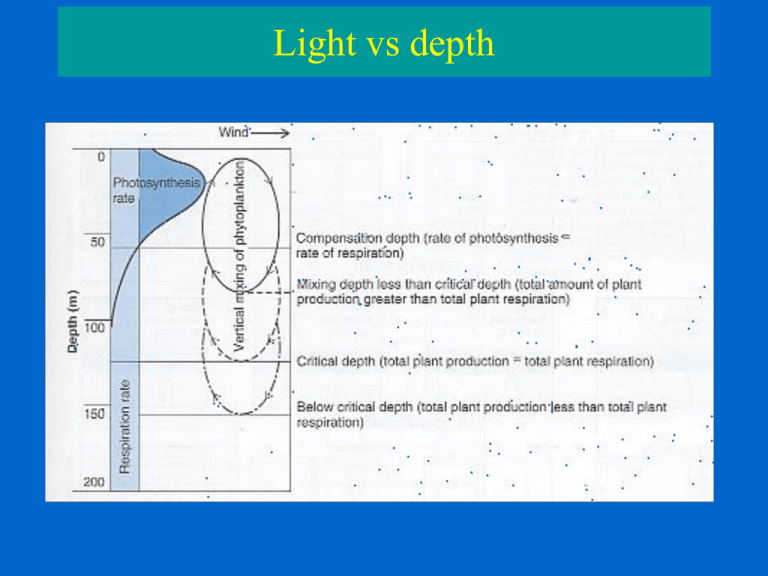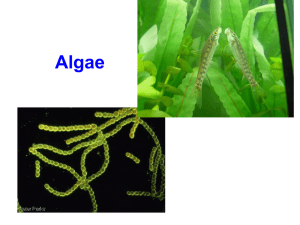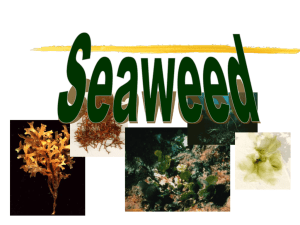Lec #7 - University of San Diego Home Pages
advertisement

Light vs depth Productivity vs depth Productivity vs Light PG – Gross Primary Productivity PN – Net Primary Productivity R - Respiration Pmax – maximal photosynthesis value Ic – compensation light intensity Primary Productivity • Found near Upwelling Areas SeaWifs Satellite Primary Productivity • Found near Upwelling Areas SeaWifs Satellite Primary Productivity • Nutrients Found near Upwelling Areas Primary Productivity • Coastal Upwelling Areas South Africa: southwest coast Primary Productivity • Equitorial Upwelling Areas Primary Productivity Protists - Zooplankton A. Foraminifera (Forams) • • • • Test (shell) made of calcium carbonate (CaCO3) or agglutinated sediment particles • Fossil tests used to age geological deposits Feed by extending pseudopodia through pores in test Pelagic forms (calcareous) • Often have spines • Tests may form foraminiferan oozes, esp. in shallow water beneath tropics (white cliffs of Dover – England) Benthic forms (calcareous or agglutinated) • Calcareous tests can be important sources of sand for beaches Protists - Zooplankton A. Foraminifera (Forams) Southern England: White Cliffs of Dover Protists - Zooplankton A. Foraminifera (Forams) Protists - Zooplankton A. Foraminifera (Forams) http://earthguide.ucsd.edu/earthguide/imagelibrary/orbulinauniversa.html http://www.ucl.ac.uk/GeolSci/micropal/foram.html Protists - Zooplankton B. Radiolarians Protists - Zooplankton C. Ciliates (Ciliophores) Seaweed & Kelp Multicellular Algae - Seaweed A. Green Algae (Chlorophytes) • Enteromorpha • • Ulva (Sea Lettuce) • • Ulva Found in areas with high nutrient levels Valonia (Bubble Algae) • • Tropical and subtropical Caulerpa • Caulerpa Often found in polluted areas; Used as bioassay tool • Invasive species (C. taxifolia) Codium (Dead Man’s Fingers) • • Multinucleated Halimeda • Calcareous alga Valonia Multicellular Algae - Seaweed A. Green Algae (Chlorophytes) • Enteromorpha • • Ulva (Sea Lettuce) • • Found in areas with high nutrient levels Valonia (Bubble Algae) • • Tropical and subtropical Caulerpa • • Invasive species (C. taxifolia) Codium (Dead Man’s Fingers) • Halimeda Often found in polluted areas; Used as bioassay tool • Multinucleated Halimeda • Calcareous alga Codium Multicellular Algae - Seaweed B. Brown Algae (Phaeophyta) • Fucus (Rockweeds) • • Laminaria Intertidal and subtidal species; Ecologically important Laminaria (Kelp) • • • Some species consist of a single blade Commonly used for food Padina Postelsia (Sea Palm) • Usually on exposed rocky shorelines Laminaria Fucus Sargassum Multicellular Algae - Seaweed B. Brown Algae (Phaeophyta) Multicellular Algae - Seaweed B. Brown Algae (Phaeophyta) • Egregia (Feather Boa) • • Common on rocky Pacific coast Pelagophycus (Elk Kelp) • Large float Multicellular Algae - Seaweed B. Brown Algae (Phaeophyta) • Macrocystis (Giant Kelp) • • May reach 100 m and grow up to 50 cm day-1 Most common in cold water Multicellular Algae - Seaweed B. Brown Algae (Phaeophyta) • Macrocystis (Giant Kelp) • • May reach 100 m and grow up to 50 cm day-1 Most common in cold water Multicellular Algae - Seaweed B. Brown Algae (Phaeophyta) • Kelp Forests Multicellular Algae - Seaweed C. Red Algae (Rhodophyta) • • Common in shallow water Contain accessory pigments called phycobilins Structurally less complex than brown algae May be heterotrophic or parasitic Some incorporate calcium carbonate into tissues (Why?) • • • • • Sebdenia Porphyra Coralline red algae Many are commercially important Halimeda Multicellular Algae - Seaweed D. Life History of Alga Multicellular Algae - Seaweed D. Life History of Alga Multicellular Algae - Seaweed E. Economic Uses of Kelp 1. 2. Food Source Products a. • • • b. • Phycocolloids Algin (Extracted from kelp; harvested with boats) Carrageenan (Extracted from red algae) • Emulsifier for dairy products, toothpaste, puddings Agar (Extracted from red algae) • Used to form jellies, thicken mixtures • Preserves, pharmaceutical applications Other Fertilizers, additives in animal feeds Flowering Plants (Angiosperms) A. Seagrasses (50 – 60 species) • • • Not true grasses (related to lilies) Roots, stems and shoots grow from horizontal rhizome Flowers typically small and inconspicuous (Why?) Flowering Plants (Angiosperms) A. Seagrasses (50 – 60 species) 1. Eelgrass (Zostera) – Temperate Atl, Pac; Tropical Pac Eelgrass (Zostera marina) Flowering Plants (Angiosperms) A. Seagrasses (50 – 60 species) 2. Surf grass (Phyllospadix) – Temperate Pac Surf Grass (Phyllospadix scouleri) Flowering Plants (Angiosperms) A. Seagrasses (50 – 60 species) 3. Turtle grass (Thalassia) – Tropical Flowering Plants (Angiosperms) B. Salt Marshes 1. Cord grass (Spartina) 2. Pickleweed (Salicornia) Salicornia Spartina Flowering Plants (Angiosperms) B. Salt Marshes 1. Cord grass (Spartina) Spartina 2. Pickleweed (Salicornia) Salicornia Flowering Plants (Angiosperms) C. Mangroves Flowering Plants (Angiosperms) C. Mangroves vs Salt Marshes








